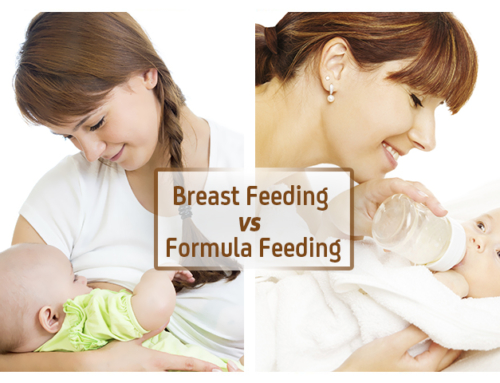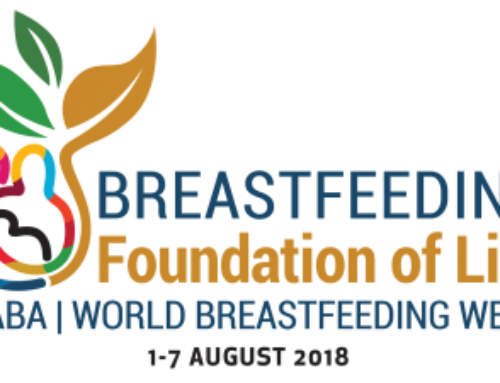For anyone that follows EP regularly, they will know I (relatively) recently posted a piece talking about one of the more common problems with breastfeeding research that no one discusses – namely, that we don’t often have a comparison group that includes what I would call evolutionary breastfeeding. That is, women who exclusively breastfeed for approximately six months (sometimes shorter) or until the introduction of solids, and then who continue to breastfeed in conjunction with solids for an extended period after. Some call this full-term breastfeeding or extended breastfeeding, but whatever the term, it reflects our evolutionary history in terms of what is biologically normal and what infants expect.
As previously discussed in said article, when we do have some type of close comparison, we often see greater effects of breastfeeding. This counters the common refrain coming out these days that the benefits of breastfeeding are overstated. Rather, we’ve been looking at it somewhat wrong: Breastfeeding isn’t a panacea, but we’ve deviated so greatly from our historical and evolutionary norm that we simply aren’t comparing the right variables.
Luckily, researchers have started to take note with at least the first element of evolutionary breastfeeding: Exclusive feeding for approximately six months. Two new pieces of research out highlight the need to include these groups (instead of comparisons like “ever breastfed” which inherently assumes breastfeeding has magical qualities) as they are the groups that allow us to see what our mixed or formula feeding norms are doing to our health. Even more notably, neither of these studies comes from the USA where a lack of maternity leave and subpar family policies create massive inequalities that influence overall health and breastfeeding practices.
The first piece of research comes from my own country, Canada, and examines the effect of breastfeeding on childhood obesity
The Nova Scotia study builds off this research and examines the type of feeding method and its relationship to obesity in children in grade 5. Importantly, exclusivity of breastfeeding was not measured with reference to the introduction of solids, but rather the use of formula. That is, mixed-feeding was not assessed as breastfeeding plus solids, only breastfeeding plus formula. This is important from an evolutionary perspective because the six month cut-off that qualifies for “exclusive breastfeeding” (by WHO standards) isn’t always held up in the evolutionary literature with infants being introduced to solids generally around that time, but sometimes earlier, sometimes later.
Parents reported on their breastfeeding habits retrospectively as part of a large-scale health study that included a large portion of the Nova Scotia grade 5 population. Four feeding groups were established, using information of feeding (i.e., breastmilk or formula) in the first year as the cut-off: (1) Only breastfed, (2) Combination fed for >= 6 months (i.e., breastfeeding was part of the combination feeding for >= 6 months), (3) Combination fed for < 6 months (i.e., breastfeeding was part of the combination feeding for < 6 months), (4) Only formula (which included anyone who breastfed less than 1 week). In addition to feeding status, food quality (i.e., the quality of the child’s diet), physical activity, and various demographic variables (including education and socio-economic status) were collected and included in the analyses.
Overall, 22% of children were classified as “overweight” and a further 12% were classified as “obese”. Only 32% of mothers reported any breastfeeding beyond six months and 34% never breastfed or breastfed less than 1 week. Without considering the covariates, there were significant effects of breastfeeding duration and the age at which formula was introduced, with a greater risk for being overweight or obese with shorter breastfeeding duration and earlier introduction of formula, starting with breastfeeding for 3 months or more. Not surprisingly, however, there were significant effects for many of the demographic variables and the diet quality and physical activity levels of children in this sample.
Once these factors were included in the analyses, there were significant effects starting at that evolutionary six month mark, with a 29% increased risk of being overweight or obese if combination fed with breastfeeding < 6 months and a 35% increased risk if solely formula fed, when compared to breastfeeding only. When only the risk of obesity is considered (and all other variables are controlled for), the risk for formula feeding only children of being obese is 57% greater than those who were only breastfed. Importantly, there was virtually no effect of combination feeding >= 6 months in any analysis, suggesting the effect isn’t inherently due to the addition of formula, but the inclusion of breastfeeding for an evolutionarily-defined period. (This would be akin to the introduction of other foods prior to six months in some cultures, with formula replacing “solid food”.)
Notably, although this study offers valuable information about the effect of evolutionary breastfeeding on later risk of obesity, it still does not fully address the evolutionary breastfeeding concerns. Namely, there is no knowledge of when, in these mixed groups, formula was introduced or what the ratio of breastfeeding to formula was. It also does not address the issue of scheduled versus cue feeds (though scheduled feeds have fallen out of favour with health professionals recommending cue feeding, but many “baby experts” still promote feeding schedules which many families follow). These are likely important variables that would influence outcomes. However, this is an important step forward in breastfeeding research as it builds upon the previous research finding a link between formula use and obesity, but provides more nuanced information about how this relationship works, dispelling the idea that “any breastfeeding” will counter the change to our evolutionary heritage.
The second study comes to us from Japan and examines the long-term effects of breastfeeding versus formula use (or combination thereof) on later hospitalizations for respiratory tract infections and diarrhea[4], two illnesses that formula-fed infants are at higher risk for during the first six months of life (when these feeding practices dominate)[5]. The evidence of long-term risks associated with formula use is mixed, with some research finding the effects wear off shortly after weaning[6] whereas others have found longer-term effects, up to 2 years later[7].
The data comes from a longitudinal cohort study in Japan in which all children born during two one-week periods in 2001 were included, with over 47,000 families taking part in the first wave of the research. For the follow-up waves, after attrition and removal of cases where the child was premature, there were between 38,000 and 39,500 children included in the analyses. Feeding status was ascertained using the parental information provided when the child was 6-7 months of age (depending on when the survey was returned) and five groups were created based on feeding history for the first 6-7 months of life: (1) formula feeding only, (2) mixed feeding with breastfeeding for 1-2 months only, (3) mixed feeding with breastfeeding for 3-5 months only, (4) mixed feeding with breastfeeding for 6-7 months, and (5) exclusive breastfeeding for the entire 6-7 months. Like the Nova Scotia study, the groups did not include weaning for solids in their grouping, just the use of formula and/or breastfeeding.
The outcome variables of interest – later cases of respiratory tract infections and diarrhea – were ascertained using hospitalization reports for either of these diseases at 18, 30, and 42 months and represented hospitalization in the past 12 months (so 6-18 months, 18-30 months, and 30-42 months). Hospitalization was used as the record as it indicated a severe intensity of the disease and provided an objective measure. In addition, various confounding factors were included in the analyses, including maternal smoking, maternal education, child sex, birth weight, childcare attendance, and siblings.
Breastfeeding status was stratified by maternal education, with greater education equaling greater likelihood of exclusively breastfeeding or mixed feeding with breastfeeding for 6-7 months (in fact, the maternal education of these two groups was nearly identical). Breastfeeding and smoking status were also related in that the less likely a woman was to breastfeed for an evolutionary duration (mixed or exclusive), the more likely she was to smoke. A child was also more likely to have formula (exclusively or mixed with less breastmilk) if their birth weight was under 2500g. Exclusive breastfeeding was also more likely if the child was an only child relative to any mixed feeding or exclusive formula use.
With respect to the outcome variables of interest, although there were these findings for the potential confounding variables, models that included all of these confounds were very similar to those that did not, suggesting that they did not play as large a role as one might think. If there was a difference, it was often upon inclusion of maternal factors, with little to no change when child characteristics were added on top.
Although the sample was large, there were (luckily) not many cases of each of these diseases, with diarrhea occurring in approximately 1-1.3% of the sample for a given time frame and respiratory tract infections occurring in approximately 2-8% depending on the time frame. At no time point was there a long-term effect of breastfeeding status on diarrhea, suggesting that the increased risk of diarrhea associated with formula use is limited to the first six months. However, there were effects on respiratory tract infections, with a linear (or near linear) relationship occurring at all time frames in which less breastfeeding was associated with greater risk for hospitalization. These effects were nearly significant (alpha was at .05) at 30 months and significant at 42 months, but non-significant 18 months. Notably, the effects for exclusive breastfeeding at 6-7 months and mixed feeding with breastfeeding for 6-7 months were nearly identical, and both were different from mixed feeding with breastfeeding for < 6 months.
This study provides evidence of long-term risks associated with formula use – both exclusive and mixed – if breastfeeding is not also included for 6-7 months, in line with the evolutionary time frame. There is, however, one limitation worth mentioning (most others actually would push results towards non-significance and thus aren’t discussed here, but are discussed in the paper): Confounding medical problems in the first six months. It is highly possible that health problems in the first six months changed feeding practices and influenced long-term health, particularly with respect to respiratory tract infections; however, this information wasn’t available to the researchers and thus could not be included in the analyses.
It’s important to note that neither of these studies actually included an analysis of true evolutionary breastfeeding as the time frame for examination of breastfeeding was limited (i.e., it did not look all the way to full weaning) and did not include percentages of breastmilk versus formula in the mixed feeding groups. However, they did better than most breastfeeding research by not only including an exclusive breastfeeding group, but also by breaking down the mixed-feeding groups into subgroups. With these breakdowns, the importance of evolutionary breastfeeding becomes clearer as both studies found differences with the groups that had breastfeeding ongoing for at least 6 months, even if there was some supplementation.
This type of research is critical as many people continue to try and make claims that the breastfeeding research isn’t as strong as it should be, yet those comments are based on unrealistic expectations of breast milk. When comparing outcomes for those who “ever” breastfed versus “never”, the idea is that breast milk would offer some crazy benefit for years to come, even if mom only breastfed for 1 week. We need to replace this thinking by looking at how our modern feeding practices deviate from an evolutionary norm in which breastfeeding occurs nearly exclusively for around six months (though solids may be introduced earlier) and then continues for approximately 18 months or more in tandem with the introduction of solids. What we have seen in some older studies that did include exclusive breastfeeding and what we see here is that this six month period of breastfeeding is key, even if it is mixed. When breastfeeding isn’t continued to this point, we see increased risk of, in these studies, respiratory tract infections and childhood obesity.
More studies are needed to establish what the role is of even this early-stage evolutionary breastfeeding on other outcomes of interest and to look further at weaning times and proportions of mixed feeding. However, one thing is clear: We have to stop looking at breast milk as all or none and instead look at it through an evolutionary lens which tells us not that one week of breastfeeding is all that’s needed, but rather it is likely the ongoing and cumulative effects of breastfeeding (or rather, not breastfeeding) that influences outcomes the most.
___________________
[1] Rossiter MD, Colapinto CK, Khan MKA, McIsaac JLD, Williams PL, et al. Breast, formula and combination feeding in relation to childhood obesity in Nova Scotia, Canada. Matern Child Health J 2015; DOI: 10.1007/s10995-015-1717-y. [2] Harder T, Bergmann R, Kallischnigg G, Plagemann A. Duration of breastfeeding and risk of overweight: a meta-analysis. American Journal of Epidemiology 2005; 162: 397-403. [3] Holmes AV, Auinger P, Howard CR. Combination feeding of breast milk and formula: Evidence for shorter breast-feeding duration from the national health and nutrition examination survey. Journal of Pediatrics 2011; 159: 186-91. [4] Yamakawa M, Yorifuji T, Kato T, Inoue S, Tokinobu A, et al. Long-term effects of breastfeeding on children’s hospitalization for respiratory tract infections and diarrhea in early childhood in Japan. Matern Child Health J 2015; DOI: 10.1007/s10995-015-1703-4. [5] Duijts L, Jaddoe VWV, Hofman A., Moll HA. Prolonged and exclusive breastfeeding reduces the risk of infectious diseases in infancy. Pediatrics 2010; 126: e18–e25. [6] Quigley MA, Kelly YJ, Sacker A. Breastfeeding and hospitalization for diarrheal and respiratory infection in the United Kingdom Millennium Cohort Study. Pediatrics 2007; 119:e837–e842. [7] Hetzner NMP, Razza RA, Malone LM, Brooks-Gunn J. Associations among feeding behaviors during infancy and child illness at two years. Matern Child Health J 2009; 13: 795-805.






Interesting and great post, as usual. Did any of those papers consider birth mode as a variable? From a microbiome perspective, the different communities in vaginally vs Cesarean delivered babies could complicate the analysis. Additionally, have you seen this paper on Swedish infants? http://www.sciencedirect.com/science/article/pii/S1931312815001626 The authors see a gut microbiome community shift from an “infant” to “adult” type community NOT with the introduction of solid food, but instead with the cessation of breastfeeding. I find that so interesting since there are so many correlations in humans and animal studies on the gut microbiome, breastfeeding, and immunity. I’m working on a post on this, but it’s on the back burner for now. Really enjoy your posts here and on FB!
I haven’t read the full piece but I’d heard about that – the birth mode is an interesting variable that was not included in either of these studies. However, for the Japanese one, the c-section rate is much lower (last record is 17%) with a very different culture of birth, so I don’t know that it would be as large as a factor as it would were the data from the USA. But it’s a great point!!!
[…] immune function is improved with extended breastfeeding. In fact, as I’ve covered here and here, the more research looks at breastfeeding in an evolutionary or biological […]